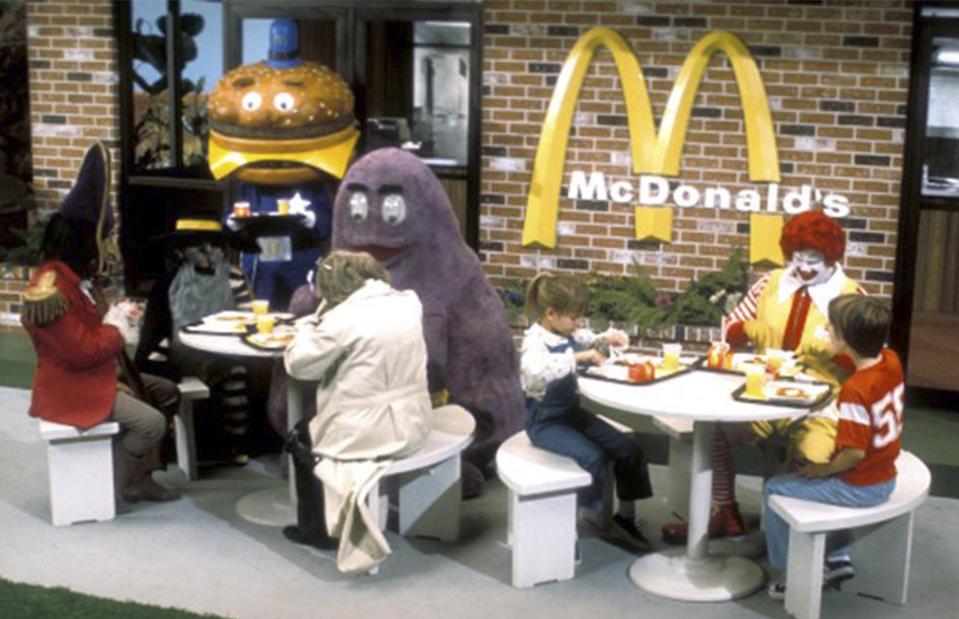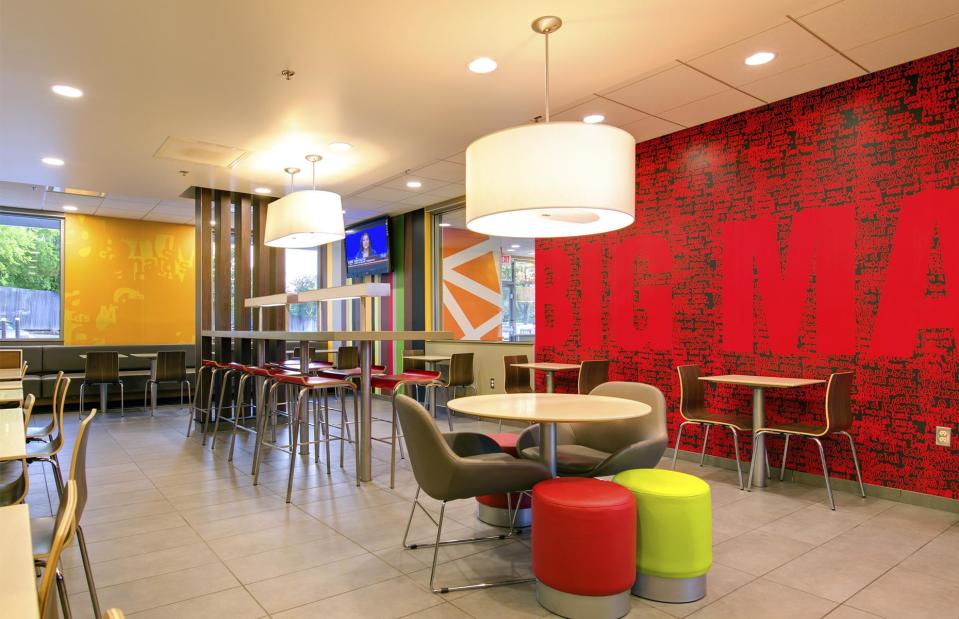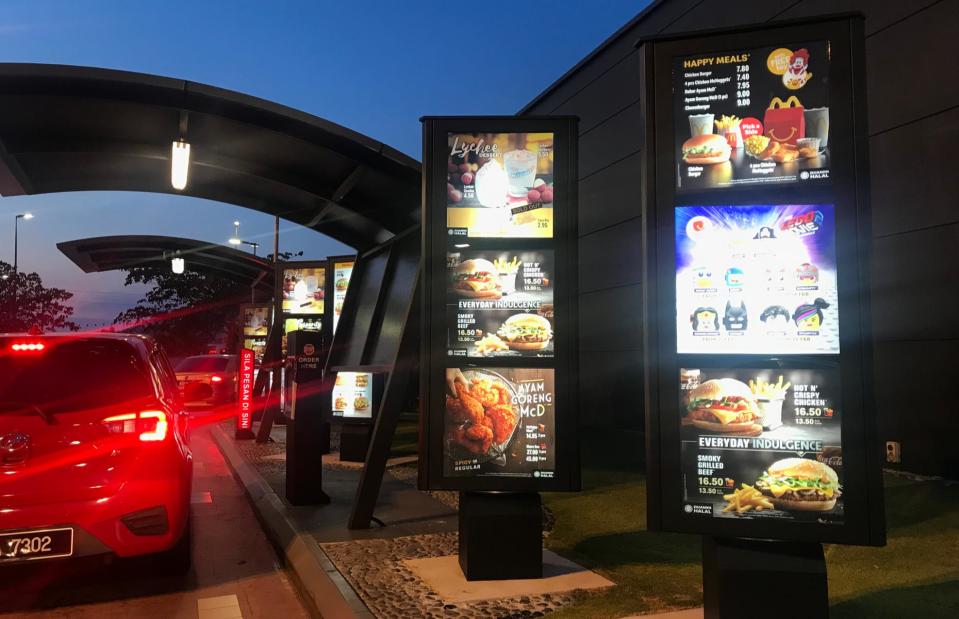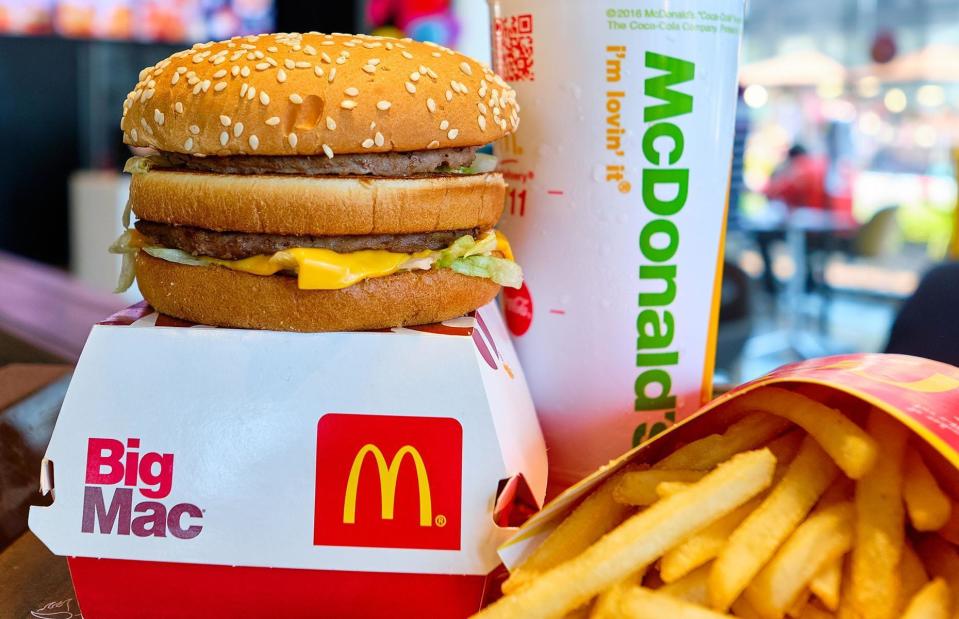Is this the world’s best McDonald’s restaurant?
Is this the world’s best McDonald’s?

Stephen Chung/Alamy Stock Photo
It’s common knowledge among fast food fans that international McDonald’s restaurants all have their own unique menu items, from poutine in Canada to South Korea’s Bulgogi Burger. But did you know there’s a little-known McDonald’s outpost where you can actually sample them all? Opened in 2018, this secret spot serves up cult-favourite burgers, unusual McFlurry flavours and all kinds of quirky regional fast foods.
Read through our gallery to discover the secret McDonald’s restaurant serving up iconic menu items from all over the world.
Welcome to Hamburger University

EricSkadson/Shutterstock
McDonald’s may have been founded in California in 1940, but its headquarters are actually located in Chicago, Illinois. Inside this gleaming facility there’s a training centre that’s aptly named Hamburger University, plus state-of-the-art test kitchens, where new and exciting dishes are constantly being cooked up. But underneath McDonald’s HQ, you’ll also find a location of the chain unlike any other: the Global Menu Restaurant.
The McGlobal menu

Courtesy of McDonald’s
Located in Chicago's West Loop neighbourhood, this unique 6,000-square-foot (557 sqm) restaurant features a rotating selection of international dishes alongside classic American favourites like Big Macs and Chicken McNuggets. The global menu changes approximately every 12 weeks, introducing new items from various countries. Popular past offerings have included fan-favourite burgers like the Ebi Filet-O Burger from Japan (a breaded shrimp burger served on a Big Mac roll with spicy sauce) and the McAloo Tikki from India, which features a samosa-inspired veggie patty made with spiced potatoes and peas.
Best bites from around the globe

Courtesy of McDonald’s
For breakfast, diners might be able to try sandwiches like the Chicken McMuffin with Egg from Hong Kong (pictured), the Veggie Muffin from India or the Bacon Roll from the UK. Lovers of all things sweet are very well catered for too. For dessert, previous offerings have included the Stroopwafel McFlurry from the Netherlands, the Salted Caramel Dipped Cone from South Korea and various flavours of McPops – Spanish doughnut bites that come stuffed with everything from chocolate-hazelnut filling to Biscoff cookie butter.
Get them while you can

Stephen Chung/Alamy Stock Photo
In addition to the diverse menu, the restaurant boasts modern global-inspired interiors with brown leather chairs and warehouse-style ceilings, as well as self-order kiosks, table service and an ever-changing wall map that illuminates the origin of each featured item. An Australian-style McCafé area also serves expertly brewed coffee crafted by McDonald's trained baristas. With the menu changing roughly every three months, the best way to see what’s currently on offer is by looking at a delivery platform like Uber Eats or the McDonald’s app.
Hungry for more? Read through our gallery to discover the amazing history of McDonald's, from its creation in 1940 to the present day.
From small fries to Big Macs

McDonalds/Facebook
Looking at McDonald’s now, with 38,000-plus restaurants in more than 100 countries, it’s hard to picture a time before it dominated the world. However, like all great success stories, McDonald’s beginnings were tough – just two working class brothers who opened a burger bar, with a dream to make $1 million before they reached the age of 50. Here, we look at how McDonald’s has transformed over the years, from its inception in 1940 to the present day.
1940: McDonald’s Bar-B-Q

McDonalds/Facebook
It all started when brothers Richard and Mac McDonald opened a drive-in called McDonald’s Bar-B-Q on 14th and E streets in San Bernardino, California, in 1940. It was nothing like the restaurants of today; carhops delivered barbecued meat sandwiches and peanut butter and jelly sandwiches to customers' cars. However, the McDonald's brothers thought they could do better and, in 1948, they closed the restaurant and reinvented it to have a menu with only nine items.
1943: retro delights

McDo_PH/Twitter/X
In the early years of McDonald’s, the menu included root beer floats, ham and baked beans, and other retro delights. And while these options were phased out in the USA in 1948, some McDonald's restaurants around the world still feel the influence of those early menu items. Today, those visiting the Golden Arches in the Philippines have the option of Coke, green apple, melon, and lychee McFloats. In 2016, select New York and Seattle McDonald's sold Dr. Pepper floats, too.
1948: Speedee the mascot

Supannee_Hickman/Shutterstock
In the days before Ronald McDonald was on the scene, McDonald's mascot was a cartoon chef named Speedee (pictured). He appeared on the McDonald’s Bar-B-Q sign in 1948 and remained part of the company until 1955, along with the original blue, red and white packaging.
1949: do you want fries with that?

8th.creator/Shutterstock
McDonald's French fries have garnered a reputation for being some of the best, yet they haven't always been the same. In 1949, McDonald’s swapped out potato chips for the stick-thin fries of today, and in 1967, when Idaho-based Simplot Company became McDonald's supplier, frozen fries took over. However, in 1992, fries cooked in beef tallow, which people claim tasted better, were swapped for those cooked in vegetable oil.
1955: the first official McDonald's

Library of Congress/Picryl
In 1954 a Chicagoan, Ray Croc, visited the McDonald brothers and immediately saw potential. He became their franchising agent, starting McDonald’s System Inc. The first of the new McDonald's restaurants was located at 400 North Lee Street in Des Plaines, Illinois, near Chicago (pictured). The iconic building, complete with Golden Arches, was designed by Stanley Meston – and first day sales totalled around $366.12 (around £290).
1963: take a seat

McDonalds/Facebook
It wasn’t until 1963 that customers could actually take a seat inside a McDonald’s restaurant. Prior to this, the restaurants were all drive-ins. The first McDonald’s to introduce a seating option was in Denver, Colorado. It would have looked similar to the seating pictured outside this McDonald's in 1970 (although we can't guarantee all the McDonaldland crew – Hamburglar, Grimace, Mayor McCheese, Captain Crook and the Big Mac – were always there).
1965: Filet-O-Fish

McDonaldsCanada/Facebook
The divisive Filet-O-Fish arrived on McDonald's menus nationwide in 1965. A breadcrumbed fish sandwich with tartare sauce and American cheese, it was invented by Lou Groen, a McDonald’s Cincinnati franchisee, in 1963. Its purpose was to elevate Friday sales numbers when Roman Catholics were abstaining from meat. It was an instant hit and was rolled out nationally two years later.
1968: the Big Mac

McDonalds/Facebook
The famous Big Mac burger landed in 1968, developed by Jim Delligatti, owner and operator of the Pittsburgh restaurant. The Big Mac is made with two beef patties, special sauce (a variant of Thousand Island dressing), iceberg lettuce, American cheese, pickles and onions, served in a three-part sesame seed bun. Today, the burger is still one of the company’s bestsellers, with roughly 28 sold globally per second.
1969: Golden Arches

LongJon/Shutterstock
In 1969, McDonald's changed its logo to the iconic red and yellow Golden Arches or 'M' the world recognises today. The colours were chosen because psychologists believe red stimulates appetite and we associate yellow with happiness. The same year also saw a massive remodelling of the restaurants.
1973: Quarter Pounder

McDonalds/Facebook
The Quarter Pounder and the Quarter Pounder with Cheese were added to the menu in 1973 and have stood the test of time. The burgers are marketed towards those looking to enjoy a less processed meal. These days, they're among few McDonald's burgers to use fresh, unfrozen beef.
1975: Egg McMuffin

Robson90/Shutterstock
Egg McMuffins were added to the national menu in 1975 after being created by Herb Peterson, who owned and operated the Santa Barbara McDonald’s in California. He modelled the sandwich on his favourite breakfast dish, eggs Benedict. By 1976, the chain had perfected its whole breakfast menu. McDonald's breakfast fans, take note – the Egg McMuffin is the only option to use freshly cracked eggs.
1975: Dawn of the drive-thru

Jonathan Weiss/Shutterstock
Sierra Vista, Arizona, was the first location of a McDonald’s drive-thru. It opened in 1975, because soldiers from the nearby Fort Huachuca weren’t allowed to get out of their cars in army uniform. McDonald’s solved the problem and the first proved so successful, drive-thrus soon opened in Georgia and Oklahoma City. It wasn’t long before the format was incorporated at many other stores.
1979: Happy Meals

Ratana21/Shutterstock
The Happy Meal was added to menus across the US in 1979. These meals originally had a circus wagon theme and came with the standard hamburger or cheeseburger, French fries, cookies, a soft drink and, of course, a toy. Over the years McDonald's has given away Beanie Babies, Pokémon figures, Disney stickers and Lego toys. In fact, in 2011, McDonald's was said to be the world's largest distributor of toys.
1983: Chicken McNuggets

Lenscap Photography/Shutterstock
McNuggets and dipping sauce were added to US menus in 1983, and their huge popularity meant McDonald's took special measures to prevent them running out. Over the years there's been controversy over what goes into McNuggets, agitated by a viral video of 'pink slime'. However, McDonald's insists they're nothing but 100% chicken breast.
1980: beyond burgers and fries

Kambui, CC BY 2.0, via Wikimedia
McDonald’s has made many attempts to expand beyond burgers and fries over the years, but they haven’t always been hugely successful. In 1980, the chain introduced the McBoat, a floating restaurant in an old-fashioned paddle steamer on the Mississippi River; it closed in 2000. In 1986, the McBarge in Canada was open for just six months. Other wacky ventures include the McPlane (pictured), a brief 1996 collaboration with Swiss air carrier Crossair and now defunct tour company Hotelplan, which saw Big Macs and Chicken McNuggets served at 35,000 feet (11km).
1987: McDonald's salads

McDonaldsCanada/Facebook
McDonald’s decided to make salad an option in 1987, adding freshly tossed ingredients with croutons and bacon bits to the menu. In 2003, the chain added premium salads, and in 2005 salads landed on UK menus. However, they're not necessarily the healthier option – some have a higher salt and calorie content than McDonald's burgers.
2001: McCafé

Air Elegant/Shutterstock
The first McCafé opened in Australia in 1993, and the concept is still going strong across the country. It didn't come to the US until 2001, though, when it debuted at a restaurant in Oak Brook, Illinois. McDonald’s customers could now enjoy the relaxed feel of a café, sip on barista-made coffee and even enjoy a slice of cake.
2011: McMakeover

McDonaldsCanada/Facebook
The fast food giant undertook a massive store-by-store makeover from 2011 omwards – the biggest in the company’s history – transforming it from a kids' fast food joint into a family restaurant. Out went the fibreglass tables, industrial steel chairs and neon interiors, and in came wooden tables, faux leather chairs and a more muted colour palette. Pictured here is a renovated McDonald's in Canada, 2011.
2014: self-serve kiosks

Sorbis/Shutterstock
Customers who didn’t want to line up to order their meal were given another option in late 2014, when self-serve kiosks were introduced. The new technology meant that instead of ordering from a cashier, customers could use touchscreens to place their order and pay, before picking food up from the counter.
2014: Create Your Taste

McDonaldsCanada/Facebook
With the rollout of self-serve kiosks in 2014, a new campaign called Create Your Taste was introduced. This meant customers could build their own burger from more than 30 premium ingredients. Options on offer included caramelised grilled onions, chilli-lime tortilla strips, guacamole and jalapeños, as well as different buns. However, it slowed down operations and customers complained it was too expensive. It ended in 2016.
2015: all day breakfast

Grzegorz Czapski/Shutterstock
For years, McDonald's customers complained about not being able to order from the breakfast menu after 10.30am. Finally, in 2015, the company responded to customers’ pleas. A limited all-day breakfast menu is now offered in certain stores – and in the US, it includes Egg McMuffins, sausage biscuits with egg, hash browns and hotcakes. Perfect if you're wanting a cheeseburger with a side of sausage McMuffin.
2015: home delivery

shanid chirammal/Shutterstock
The ultimate game changer was McDonald’s delivery via UberEats, keeping McDonald's competitive with fast food delivery services such as Grubhub (in the US) and Deliveroo (in the UK). The company offered the service for years in Indonesia, but it wasn’t until 2015 that it launched in New York, and 2017 in the UK.
2016: table service

Courtesy of McDonald’s
In 2016, McDonald's introduced table service at some restaurants, a system whereby customers ordered their food at the counter or self-service kiosk and waiters would deliver it to the table. Its intention was to compete with more upmarket rivals such as Five Guys and Shake Shack.
2016: new décor

Courtesy of McDonald’s
Building on its 2011 makeover, McDonald’s continued to change its image and restaurant interiors in 2016. Six modern new designs were born: Allegro, Craft, Simply Modern, Fresh and Vibrant, Form and Living Room. They were contemporary and colourful, with bold graphics and easy-to-read digital menu boards.
2017: mobile order and pay

Ricky Of The World/Shutterstock
In 2017, McDonald’s began testing mobile ordering and payments in select US restaurants. By the end of the year, it was rolled out across the US, Canada, the UK, France, Germany, Australia and China. The ordering service means customers are able to order food and pay via their phone, before picking it up from the restaurant or having it delivered.
2017: digital drive-thru

cypopcolour/Shutterstock
McDonald’s has even made its drive-thru menu boards digital. These boards change throughout the day to show customers the most timely and relevant deals and menu items. The chain also introduced double-lane drive-thrus to make the experience speedier. Very different from the days where there were paper menus that carhop waitresses offered through the car window.
2019: sleek new style

Courtesy of McDonald's
At the end of 2018, McDonald’s revealed plans to invest $6 billion (around £4.7bn) on modernising 14,000 restaurants before 2020. The sleek new designs were called Alphabet 1, Alphabet 2, Wood & Stone, Ray and Natural Integrity. The minimalist black, white and wooden colour palette is a contrast to the bright and bold colour schemes of the past and is reflective of McDonald's in the digital era.
2021: AI errors

P_WON/Shutterstock
In 2021, the fast food giant announced plans to trial AI processing technology. Powered by tech company IBM, this new system set out to use voice recognition to process drive-thru orders. The test took place across 100 restaurants over two years, before being dropped in summer 2024, following issues such as customers receiving entirely different items from what they'd ordered. McDonald’s has commented that while it has been discontinued for now, this system is likely to be a part of the brand’s future.
2023: a new take on McDonald's

Courtesy of CosMc's
Early in 2023, McDonald's unveiled plans to open a retro space-themed restaurant called CosMc’s, inspired by (and named after) a loveable alien mascot that appeared in its adverts more than 30 years ago. After months of speculation over what the new restaurant might be like, the first branch was finally unveiled in Bolingbrook, Illinois, at the end of 2023, with fast food fans waiting in line for hours to see what CosMc's was all about. Over the next year, six more locations popped up – all in Texas.
2023: out of this world items

Courtesy of CosMc's
CosMc's seems to have been positioned as a rival to popular coffee chains like Starbucks, offering an extension of the existing McCafé range. The menu is packed with adventurous-sounding creations like the Popping Pear Slush, Churro Frappe and Spicy Queso Sandwich, alongside classic McDonald's breakfast options such as the Egg McMuffin and hash browns. However, in early 2025, less than a year after McDonald’s launched the spin-off restaurant, the brand announced it was shuttering half of them. But it's not all bad news – it will also be opening two new smaller format stores in Texas later in 2025.
2023: in search of burger perfection

KULLAPONG PARCHERAT/Shutterstock
Aside from limited-edition specials and regional variations, you can usually rely on McDonald's classic burgers to taste a certain way. In fact, we bet McDonald's fans could easily identify a Big Mac or other menu mainstay while blindfolded. But all that changed in spring 2023, when the chain announced some pretty major upgrades to its most legendary recipes, to improve the buns, cheese and even how its patties are cooked. The changes (50 in total) were initially trialled in McDonald's locations in Australia, Canada and Belgium, before being rolled out slowly in the USA.
2024: meltier cheese and more sauce

Courtesy of McDonald's
The upgrades included cooking the beef patties in smaller batches of six (instead of eight) to give them a crispier, more consistent sear. Several iconic items, including the Big Mac and classic cheeseburger, now boast softer brioche buns with sesame seeds that are toasted until golden brown. The finished burgers also have fresher lettuce and pickles and ‘hotter, meltier cheese’, while the quintessential Big Mac is loaded with even more sauce. The changes were implemented in the UK in March 2024, with a global rollout on the way.
2024: a new future for the Happy Meal

Ratana21/Shutterstock
Brimming with kid-sized menu items and a miniature toy, the Happy Meal has been delighting children across the globe for over four decades. But in spring 2024, McDonald’s announced it would be making drastic changes to the offering. New Happy Meal items include adding Fish Bites (breadcrumbed pollock) and Saver Menu favourite Mayo Chicken alongside its current main options, as well as new flavoured milk cartons and the McFreezy, a frozen dessert made with fruit juice and pureé. Trials will take place across the UK before potentially being introduced elsewhere.
2024: a new Saver Menu

6428W Digital Art/Shutterstock
The revamped Happy Meal is not the only change brewing; in spring 2024, McDonald’s unveiled an affordable menu called ‘3 for £3’, allowing UK diners to mix and match everything from a cheeseburger and veggie dippers to a small fries and apple pie. Initially launched for a limited-run period, the mega-chain announced a return due to popular demand, with the deal coming back from 31 July, 2024. We're hoping it sticks around for good this time and that similar launches are made internationally.
2024: McDonald's celebrates 50 years in the UK

Evening Standard/Hulton Archive/Getty Images
In 2024 McDonald celebrated 50 years in the UK by launching a new menu – with a host of fan-favourite meals making a comeback. The Double Big Mac made a welcome return, as did the McCrispy BBQ Smokehouse. There was also a new Birthday Cake Donut and a Milkybar Raspberry Ripple McFlurry to round out the birthday party vibe. The restaurant has clearly come a long way, from one diner in 1974 to 1,435 in 2024 – and that's only in the UK.
2025: McDonald’s biggest ever burger

Courtesy of McDonald’s Canada
Anticipation levels have been rising since McDonald’s announced in late 2023 that it would be launching its biggest ever burger. Named the Big Arch, it’s one of the chain’s most extravagant launches to date. Available in select markets, including Canada and Portugal, the Big Arch features two quarter-pound 100% beef patties layered with three slices of cheese, crispy onions, pickles, lettuce and a tangy new Big Arch sauce, all inside a soft bun. McDonald’s has plans to roll it out globally, so fans elsewhere shouldn't have to wait too long before trying it.


